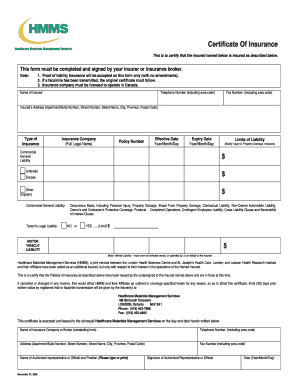Fill and Sign the Hmms Certificate of Insurance Form

Useful suggestions for completing your ‘Hmms Certificate Of Insurance Form’ online
Are you exhausted by the inconvenience of handling documents? Look no further than airSlate SignNow, the premier eSignature solution for individuals and businesses. Bid farewell to the monotonous task of printing and scanning forms. With airSlate SignNow, you can effortlessly complete and sign documents online. Take advantage of the extensive features integrated into this user-friendly and cost-effective platform and transform your method of document management. Whether you need to approve forms or gather eSignatures, airSlate SignNow manages it all effortlessly, with just a few clicks.
Adhere to this step-by-step guide:
- Access your account or register for a free trial with our service.
- Click +Create to upload a file from your device, cloud storage, or our form library.
- Open your ‘Hmms Certificate Of Insurance Form’ in the editor.
- Click Me (Fill Out Now) to finalize the document on your end.
- Add and designate fillable fields for others (if necessary).
- Continue with the Send Invite options to solicit eSignatures from others.
- Save, print your copy, or convert it into a reusable template.
Don’t worry if you need to collaborate with others on your Hmms Certificate Of Insurance Form or send it for notarization—our platform provides everything you need to accomplish such tasks. Register with airSlate SignNow today and elevate your document management to new levels!
FAQs
-
What is the Hmms Certificate Of Insurance Form?
The Hmms Certificate Of Insurance Form is a document that provides proof of insurance coverage for businesses or individuals. This form details the types of insurance coverage held and ensures that all parties involved are protected. Using airSlate SignNow, you can easily create, send, and eSign the Hmms Certificate Of Insurance Form without any hassle.
-
How can airSlate SignNow help me manage the Hmms Certificate Of Insurance Form?
airSlate SignNow streamlines the management of the Hmms Certificate Of Insurance Form by allowing you to create and customize templates. You can quickly send the form to clients or colleagues for eSignature, making the process efficient and secure. Our platform simplifies tracking and storing these important documents, ensuring you always have access to them.
-
Is airSlate SignNow affordable for small businesses needing the Hmms Certificate Of Insurance Form?
Yes, airSlate SignNow offers cost-effective pricing plans that are suitable for small businesses needing the Hmms Certificate Of Insurance Form. Our plans are designed to accommodate different business sizes and budgets, providing essential features without breaking the bank. This makes it easy for small businesses to manage their insurance documentation efficiently.
-
What features does airSlate SignNow offer for the Hmms Certificate Of Insurance Form?
airSlate SignNow offers a range of features for the Hmms Certificate Of Insurance Form, including customizable templates, secure eSignature options, and real-time document tracking. You can also integrate with popular applications to streamline your workflow. These features ensure that you can manage your insurance forms easily and effectively.
-
Can I integrate airSlate SignNow with other software when handling the Hmms Certificate Of Insurance Form?
Absolutely! airSlate SignNow allows seamless integration with various software platforms, making it easy to manage the Hmms Certificate Of Insurance Form alongside your existing tools. This includes CRM systems, cloud storage, and other productivity applications. Integrating SignNow enhances your document management process, increasing efficiency.
-
How secure is the Hmms Certificate Of Insurance Form when using airSlate SignNow?
Security is a top priority at airSlate SignNow. When handling the Hmms Certificate Of Insurance Form, your documents are protected with advanced encryption and secure storage solutions. This ensures that sensitive information remains confidential, giving you peace of mind while managing your insurance documents.
-
Can I access the Hmms Certificate Of Insurance Form on mobile devices with airSlate SignNow?
Yes, airSlate SignNow is fully mobile-compatible, allowing you to access the Hmms Certificate Of Insurance Form on your smartphone or tablet. This flexibility means you can send, sign, and manage your insurance forms from anywhere, making it convenient for busy professionals on the go.
Related searches to hmms certificate of insurance form
Find out other hmms certificate of insurance form
- Close deals faster
- Improve productivity
- Delight customers
- Increase revenue
- Save time & money
- Reduce payment cycles

